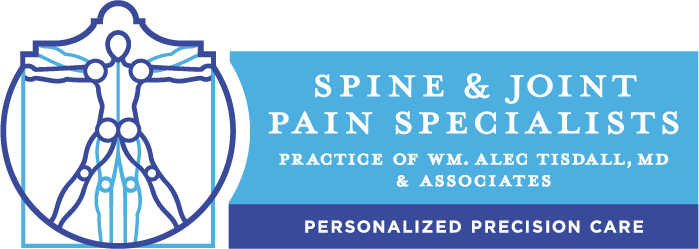
Services and Treatments
At Spine and Joint Pain Specialists we are committed to providing the highest quality care to our patients. Our treatments are minimally invasive and clinically proven to be highly effective. Dr. Tisdall and his team provide each patient with a full evaluation to determine the patient's best options for pain management. It is our goal to provide each patient with an individualized plan of care to improve pain control, while considering each patient's special needs.

Epidural Steroid Injection
An epidural steroid injection (ESI) places pain-relieving medicines into the space around the spinal cord and nerve roots. The injection combines a local anesthetic for immediate pain relief with a corticosteroid for greater comfort in the long-term.
Facet Joint Injection
The facet joint is where a vertebra connects with another. Injecting an anesthetic and/or corticosteroid in the facet joint can relieve pain in the back and other areas of the body.
Knee Injection
Knee injections supplement the joint’s natural lubrication, helping the joint move more smoothly and comfortably.
Spinal Cord Stimulation
Implantation of a tiny device that sends electrical impulses into the space around the spinal column and nerve roots can reduce chronic back pain and/or limb pain. This is a minimally-invasive surgical procedure.
Radiofrequency Ablation
A non-invasive therapy that uses electrical current produced by a radio wave to heat the nerve tissue in the targeted area, interrupting and decreasing the pain signals the nerves are sending out.
Lumbar Epidural Steroid Injection
A lumbar epidural steroid injection (LESI) places pain-relieving medicines into the space around the spinal cord and nerve roots in the lumbar region of the spine (lower back.)
Cervical Epidural Steroid Injection
A cervical epidural steroid injection (CESI) places pain-relieving medicines into the space around the spinal cord and nerve roots in the cervical region of the spine (neck and upper back.)
Transforaminal Epidural Steroid Injection
Transforaminal ESI is a precisely-targeted injection that delivers pain-relieving medicine into the neural foramen that contains the pain-causing nerve root. The foramen is the opening between vertebrae where spinal nerve roots exit to other parts of the body.
Shoulder Injection
An injection of local anesthetic and a corticosteroid into the shoulder joint can help reduce shoulder pain caused by a variety of disorders.
Sacroiliac Joint Injection
You have two sacroiliac joints (SI joint) in your lower back, one on each side of your spine where it meets your pelvis. These joints carry the weight of your upper body, so physical stress and injury can cause chronic pain, as can arthritis in the SI joint.
Discogram / Discography
A discogram is a test to evaluate back pain and determine if an abnormal disc in your spine is the cause of your pain. By injecting dye into the soft center of the disc and viewing the result on a CT scan or x-ray, your doctor can see if the disc is damaged or deteriorated.


